Chapter 9: Aggregate Supply and Aggregate Demand
1/23
There's no tags or description
Looks like no tags are added yet.
Name | Mastery | Learn | Test | Matching | Spaced |
|---|
No study sessions yet.
24 Terms
Comparative Statics for Microeconomics
Price and quantity changes are the result, NOT the cause, of economic event
Start with one equilibrium situation (intersection of supply and demand, other things the same)
Change one variable
Compare resulting equilibrium situation (intersection of supply and demand after the change) in terms of price and quantity
Comparative Statics for Macroeconomics
Changes in real GDP, unemployment, and inflation are the result, NOT the cause of economic events
Start with one equilibrium situation (intersection of aggregate supply and aggregate demand, other things the same)
Change one variable
Compare resulting equilibrium situation (intersection of aggregate supply and aggregate demand after the change) in terms of real GDP, unemployment, and inflation
Long-Run Aggregate Supply (LAS)
Models the macroeconomic target outcomes of potential GDP and full employment with existing inputs
Quantity of real GDP supplied when all inputs fully employed
Long-run aggregate supply curve: vertical line at potential GDP — potential GDP does not change when price level changes
Points on production possibilities frontier (PPF)
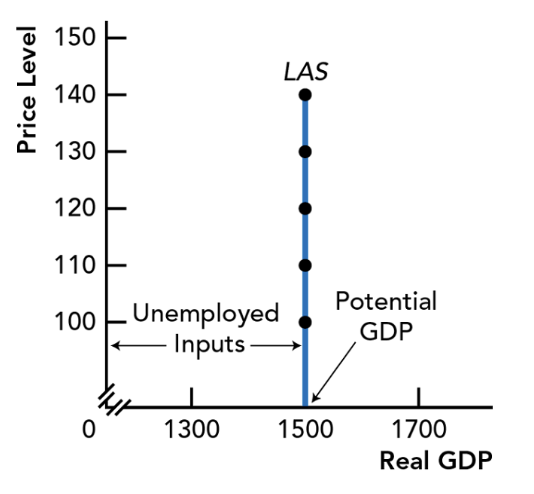
Time Periods for Macroeconomic Analysis
Long-Run: a period of time long enough for all prices and wages to adjust to equilibrium
Economy at potential GDP
The full employment outcome of coordinated smart choices
Prices flexible in both input and output markets
Short-Run: a period of time when some input prices do not change
All prices have not adjusted to clear all markets
Prices fixed in input markets, but flexible in output markets
Macroeconomic players (consumers, businesses, government) make two kinds of plans for supplying realm GDP
Supply plans for existing input (With this new factory, how many workers does a business hire?)
Supply plans to increase input (Should the business build a new factory?)
Short-Run Aggregate Supply (SAS)
Quantity of real GDP macroeconomic players plan to supply at different price levels
Law of Short-Run Aggregate Supply: as price level rises, aggregate supply of real GDP increases
Changes in price level cause movement along an unchanged short-run aggregate supply curve
Movement of LAS and SAS
Supply plans to increase quantity or quality of input cause increase in aggregate supply
Changes in the quantity or quality of inputs shift both long-run aggregate supply curve (LAS) and short-run aggregate supply curve (SAS) in the same direction
Both aggregate supply curves shift rightward for increase in inputs; shift leftward for decrease in inputs
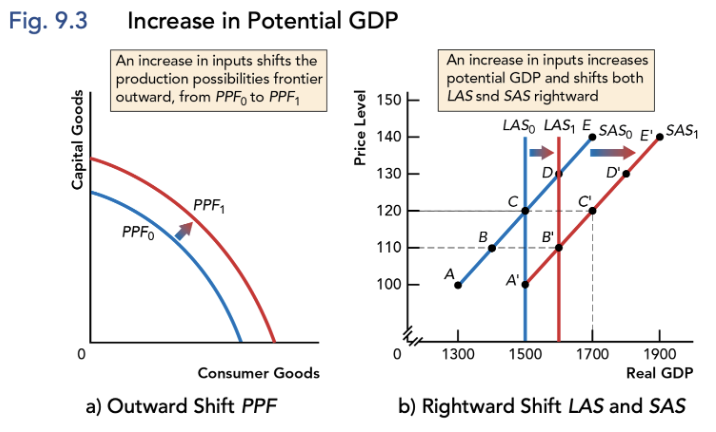
Changes in input prices…
Shift short-run aggregate supply curve (SAS) but do NOT shift long-run aggregate supply curve (LAS)
Rising input prices shift SAS leftwards — decrease willingness to supply
Falling input prices shift SAS rightwards — increase willingness to supply
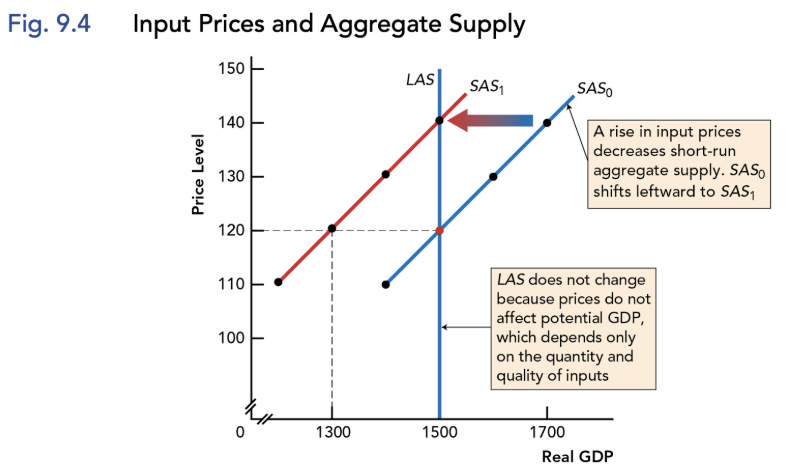
Supply Shocks
Aggregate supply increases/decreases based on shocks (aggregate quantity supplied rises/falls based on price level)
Negative Supply Shocks: directly increase costs or reduce inputs, decreasing short-run aggregate supply — SAS shifts leftward
Positive Supply Shocks: directly decreases costs or improve productivity, increasing short-run aggregate supply — SAS shifts rightward
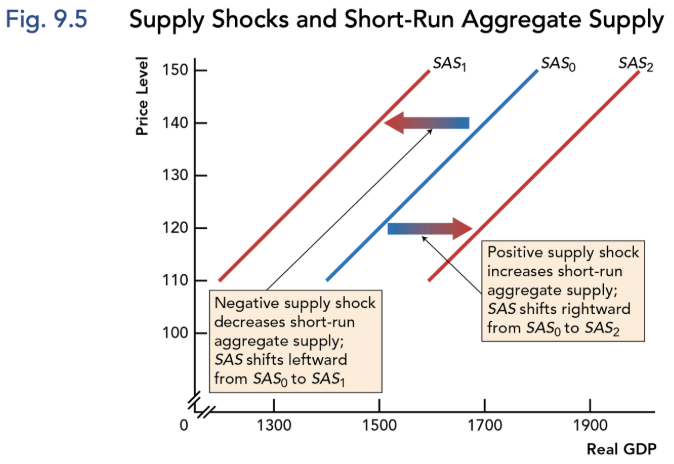
Aggregate Demand (AD)
Quantity of real GDP macroeconomic players plan to demand at different price levels
There will be changes in aggregate demand if taxes changes
Law of Aggregate Demand: as price level rises, aggregate quantity of real GDP decreases
Fallacy of Composition
Makes macroeconomic law of aggregate demand different from microeconomic law of demand
When prices rise for all Canadian products and services, only substitutes are important from R.O.W.
Canadians buy more imports, and R.O.W buys fewer Canadian Exports
Planned Spending on Aggregate Demand = Planned C + Planned I + Planned G + Planned (X-IM)
Consumers plan to spend (C) a fraction of disposable income and save the rest
Consumer spending is the largest, most stable component of aggregate demand
Disposable income = income - taxes + transfers
Business plan investment spending (I) for new factories and equipment
Investment spending plans quickly change (volatile) because easily postponed
Can directly change aggregate demand and long-run aggregate supply
Government spending plan (G) for products and service set by budget
Transfer payments are not part of G
G as a percentage of real GDP stable since early 1990s
R.O.W spending plans (X) for Canadian exports
Must subtract imports (IM) from all other planned spending to get net exports (X-IM)
Demand Shocks
Changes in factors, other than price level, that change aggregate demand and shift aggregate demand curve (AD)
Expectations
Interest Rates
Government Policy
GDP in R.O.W.
Exchange Rates
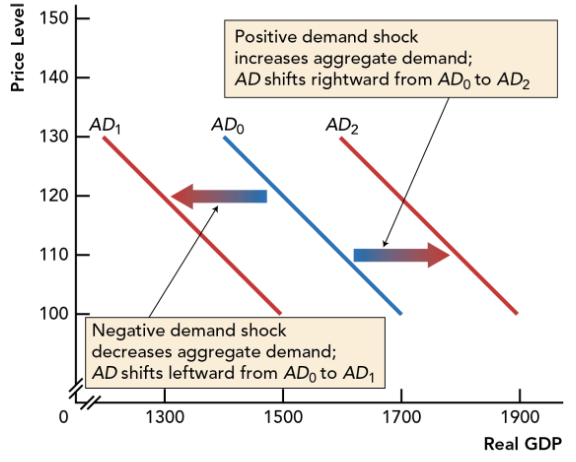
Negative Demand Shocks
Decrease aggregate demand — AD shifts leftward
More pessimistic expectations (affect I)
Higher interest rates (affect I or C)
Lower government spending or higher taxes (affect G)
Decreased in R.O.W. (affects X, IM)
Higher value of Canadian dollar (affects X, IM)
Positive Demand Shocks
Increase aggregate demand — AD shifts rightward
Les pessimistic expectations (affect I)
Lower interest rates (affect I or C)
Higher government spending or higher taxes (affect G)
Increased in R.O.W. (affects X, IM)
Lower value of Canadian dollar (affects X, IM)
SAS vs. AD vs. LAS
SAS: short-run supply plans by all macro players with fixed inputs
AD: short-rum demand plans by all macro players
LAS: a performance target, where all economists want to end up
Short-Run and Long-Run Macroeconomic Equilibrium
In macroeconomic equilibrium, aggregate demand matches aggregate supply and there is no tendency to change
Short-Run Macroeconomic Equilibrium: with existing inputs is point wheres short-run aggregate supply (SAS) and aggregate demand (AD intersect
Long-Run Macroeconomic Equilibrium: with existing inputs is the point where SAS, AD, and LAS all intersect
Aggregate quantity supplied and aggregate quantity demand of real GDP also equal potential GDP
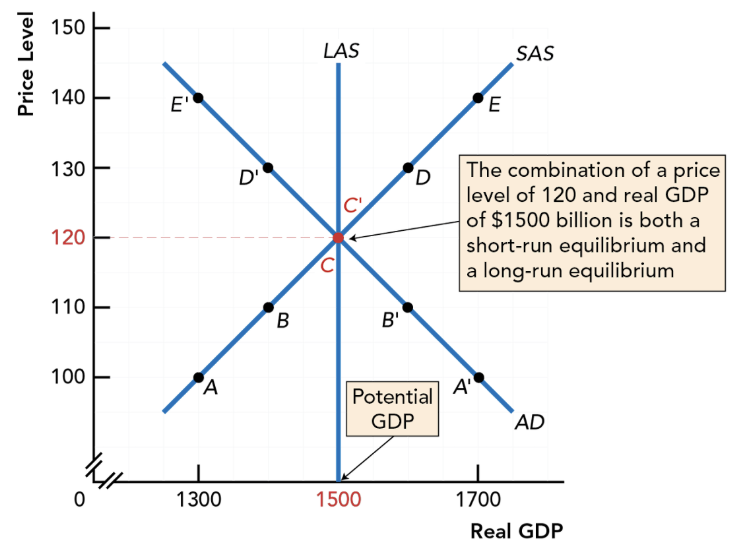
Economic Growth, Rising Living Standards, and Stable Prices
For macroeconomic equilibrium over time with increasing inputs, business investment spending is key to steady growth in living standards, continued full employment, stable prices
Business investment that increases quantity and quality of inputs shifts both SAS and LAS rightward, potential GDP increases
Increased employment in new and improved factories increases incomes in input markets, so aggregate demand (AD) shifts rightward
New LAS, SAS, and AD curves all intersect, so full employment continues with stable prices, growth in living standards from increased potential GDP
Four mismatches between aggregate demand and aggregate supply move the economy away from long-run equilibrium targets
Negative demand shocks
Positive demand shocks
Negative supply shocks
Positive supply shocks
Negative Demand Shocks
Cause a recessionary gap
Falling average prices
Decreased real GDP (Y)
Increased unemployment
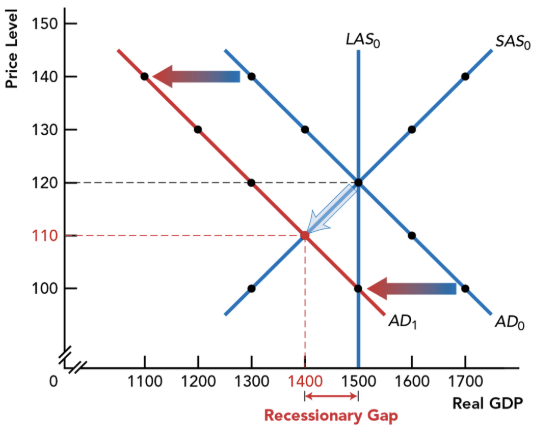
Positive Demand Shocks
Cause inflationary gap
Rising average prices
Increased GDP (Y)
Decreased unemployment
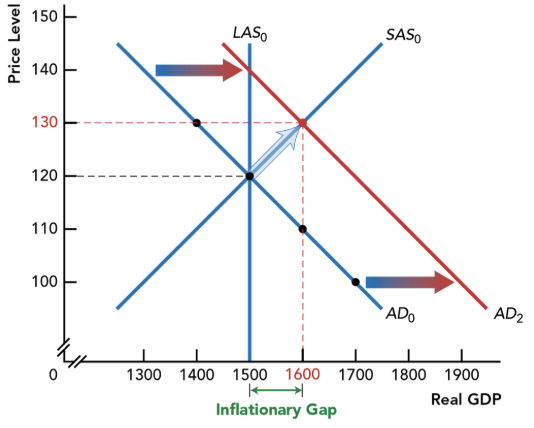
Negative Supply Shocks
Cause stagflation
Rising average prices
Decreased GDP (Y)
Increased unemployment
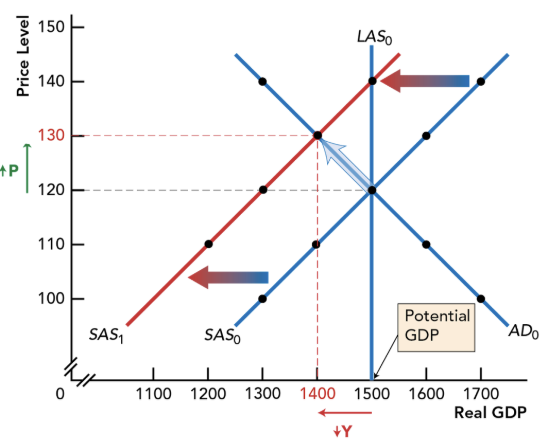
Positive Supply Shocks
Falling average prices
Increased GDP (Y)
Continued full employment
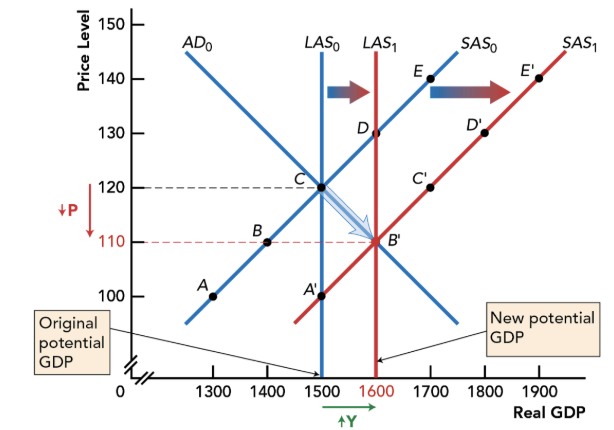
Using AS/AD Model to Think Like an Economist
To analyze any economic situation, always start in long-run macroeconomic equilibrium, where LAS, SAS, and AD all intersect, and do comparative statics
Remember LAS is different from SAS and AD; LAS is a performance target, SAS and AD are plans
Model a macroeconomic event as one of the four possible shocks — positive/negative aggregate supply/demand shocks
At new short-run equilibrium, examine the results of the shock on real GDP, unemployment, inflation